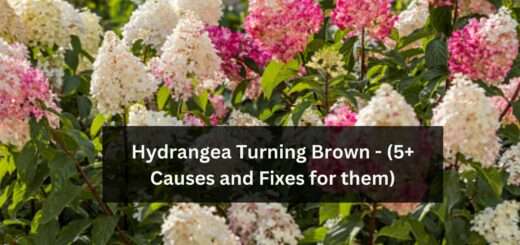Why is my Hydrangea wilting? – How to fix it?
If you have the same question, Why is my Hydrangea wilting? then here we have the answer to this question. There are several problems that a plant has to go through during its lifecycle. Some are natural and some are caused by not taking proper care of the plant. Wilting of plants is one of the common issues that a gardener faces while growing any plant. Every gardener wants to avoid diseases and problems caused to their plants and wishes them to grow healthier. So, it is important to know how you can deal with these problems easily and get rid of them just like getting rid of the ants from tomatillo plants.
Key takeaways:
- Wilting is a lack of stiffness in a plant’s nonwoody components.
- It happens when the water content of the cells in the plant tissue, especially the leaves, is extremely low or nonexistent.
- Wilting is a plant’s defensive mechanism against a lack of water.
- It is very commonly seen in hydrangeas species of plants.
In simple words, you can remember that when a plant doesn’t get enough water supply then its leaves get rolled up to decrease the surface area.
In this article, we will focus on the factors responsible for this problem and we will go through various tips and methods to solve this problem.
About Hydrangeas Plant
These exquisite plants are simple to grow, withstand nearly any sort of soil, and produce an abundance of blossoms that are unmatched in the world of shrubs for their stunning flowers. These plants are a good choice for you if you are thinking of making your garden or house more colorful. It is advised to grow them under abundant sunlight and they require a scheduled water supply. It can be grown in pots also, just maintain proper care.
Why is my hydrangea wilting?
Overwatering, underwatering, extremely high temperatures, and chilly draughts can cause hydrangeas to droop. There can be other factors responsible. So, let us read about them one by one.
Overwatering or Underwatering
Water is necessary for the plant for various biological processes but sometimes people often overwater their plant. The simple thing is, overwatering is forcing any plant to drink more water than its accommodation. In case when you pot this plant, the capacity to absorb water reduces, and the remaining water is absorbed by the soil which affects the roots of these plants. Insufficient supply makes this problem more frequent.
To know more about the plant world, you may also read related articles, Why is my Lavender Plant wilting? (How to fix it?)
Temperature
This is also an important part on which you should focus. Proper temperature is necessary for a plant to grow. Both extreme temperatures are harmful to the health of the plant. Heat-induced leaf transpiration increases in hydrangeas. If the temperature is too cold it will freeze the water which can further rupture the plant cells.
Root Damage
Roots are an important source for absorbing all the necessary minerals and nutrients for the plant. Once damaged, it will no longer perform as intended, which will cause water absorption to decrease. It then causes your hydrangea plant to begin to wilt. There can be various reasons responsible for the root damage like erosion or mishandling during potting.
Fertilizer Problem
The fertility of the soil is also important. But sometimes these fertilizers may also harm your plant. Overfertilized hydrangeas will exhibit withering of their bottom leaves. This is mostly caused by an excess of soluble salts in the soil that prevents water from reaching the roots. The root system becomes stressed as a result. The pH level increases which is harmful to the good microorganisms.
How to fix it?
Wilting can reduce the ability of photosynthesis in plants and harm their growth. Permanent wilting can cause the death of a plant. So, it is very much necessary for you to take action as soon as possible for minimal loss. Here, in this section, we will discuss some tips to solve this problem.
Proper sunlight
Sunlight may evaporate water from the soil making the plant lack sufficient water. Avoid your hydrangea plant from direct and too much sunlight. Hydrangea can bear direct morning sunlight but it just requires shade of light in the afternoon. So, pot your plant accordingly.
Transplant
You should also take care of the proper time of the year to transplant hydrangea. To give the hydrangea’s root system time to grow in the soil without having to deal with sweltering Summer heat, it is recommended to transplant hydrangeas in the Spring or Fall rather than in the Summer.
Soil
Ideally, you should replant the hydrangea in a section of the garden that has been thoroughly prepared with loads of compost if your soil is sandy, rocky, and drains extremely rapidly. Keep your soil more fertile by adding compost, leaf mold, or well-rotted manure. These three items are best for providing good soil structure and all necessary nutrients. The addition of manure to the soil will keep it moist which is good for the root system of the plant.
Scheduled Watering
Keep on providing water to the plant frequently, so that soil remains moist. Now, many people doubt how frequently we should water our plants. There is no universal answer to this question. Just keep a proper check on your plant and whenever the soil gets dry just pour some water around 2 inches into the soil.
The use of these tips and making suitable conditions for hydrangea will surely revive it from wilting. You have to keep your eye on the plant because sometimes wilting can be solved easily with these methods but it depends on how much damage is caused to your plant. If wilting is still there after doing all these tips then there is less chance of the plant surviving.
Concluding lines
In this guide, you come to know that Wilting of plants is one of the common issues that a gardener faces while growing any plant. Every gardener wants to avoid diseases and problems caused to their plants and wishes them to grow healthier. So, it is important to know how you can deal with these problems easily and get rid of them. read the guide so that you come to know why your hydrangea is wilting and the ways you can fix them.
FAQ‘s
Why are my Hydrangea Blooms turning brown?
Your Hydrangea blooms turn brown when they do not meet their basic needs and suffer stress. Being a healthy plant, all need to be watered regularly, well-drained soil, and proper sunlight but when they do not get these components, then the Hydrangea plant starts to turn its blooms brown.
How do you know when a hydrangea needs watering?
You can come to know when your Hydrangea needs water by putting a finger in the soil one inch down and if it feels dry, then you can water the plant.



